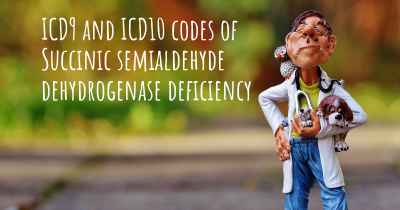What is the history of Succinic semialdehyde dehydrogenase deficiency?
When was Succinic semialdehyde dehydrogenase deficiency discovered? What is the story of this discovery? Was it coincidence or not?

Succinic semialdehyde dehydrogenase deficiency (SSADH deficiency) is a rare genetic disorder that affects the metabolism of a neurotransmitter called gamma-aminobutyric acid (GABA). This condition is also known as 4-hydroxybutyric aciduria or GABA-transaminase deficiency. SSADH deficiency was first described in the medical literature in the early 1980s.
Discovery and Early Research:
The first documented case of SSADH deficiency was reported in 1981 by Gibson et al. The researchers described a 4-year-old boy with developmental delay, hypotonia, and seizures. They found elevated levels of a compound called gamma-hydroxybutyric acid (GHB) in the boy's urine, which led them to suspect a metabolic disorder. Further investigations revealed a deficiency of the enzyme succinic semialdehyde dehydrogenase, which is responsible for the breakdown of GHB.
Understanding the Genetic Basis:
Over the years, scientists have made significant progress in understanding the genetic basis of SSADH deficiency. The ALDH5A1 gene, located on chromosome 6, was identified as the gene responsible for encoding the SSADH enzyme. Mutations in this gene lead to a deficiency or dysfunction of the enzyme, resulting in the accumulation of GHB and its precursor, succinic semialdehyde.
Clinical Presentation and Symptoms:
SSADH deficiency can present with a wide range of symptoms, which can vary in severity. Common features include developmental delay, intellectual disability, hypotonia (low muscle tone), ataxia (lack of coordination), and seizures. Behavioral problems, such as hyperactivity and autistic-like behaviors, may also be observed. Some individuals with SSADH deficiency may have speech and language difficulties, sleep disturbances, and psychiatric symptoms.
Diagnosis and Management:
Diagnosing SSADH deficiency can be challenging due to its rarity and variable presentation. Laboratory tests, including urine organic acid analysis and measurement of GHB levels, can aid in the diagnosis. Genetic testing can confirm the presence of mutations in the ALDH5A1 gene.
Currently, there is no cure for SSADH deficiency. Treatment primarily focuses on managing the symptoms and improving the quality of life for affected individuals. This may involve a multidisciplinary approach, including physical therapy, speech therapy, and educational interventions. Medications such as GABA analogs and antiepileptic drugs may be prescribed to control seizures and improve neurological symptoms.
Research and Future Directions:
Research efforts are ongoing to better understand the underlying mechanisms of SSADH deficiency and develop potential therapeutic strategies. Animal models, such as mice with SSADH deficiency, have been instrumental in studying the disease and testing novel treatments.
One promising avenue of research involves gene therapy, which aims to introduce a functional copy of the ALDH5A1 gene into affected individuals. Preclinical studies using gene therapy approaches have shown promising results in animal models, but further research is needed before it can be translated into clinical trials.
Conclusion:
Succinic semialdehyde dehydrogenase deficiency is a rare genetic disorder that affects the metabolism of GABA. It was first described in the early 1980s, and since then, significant progress has been made in understanding its genetic basis and clinical presentation. Although there is currently no cure for SSADH deficiency, ongoing research offers hope for future therapeutic interventions.








